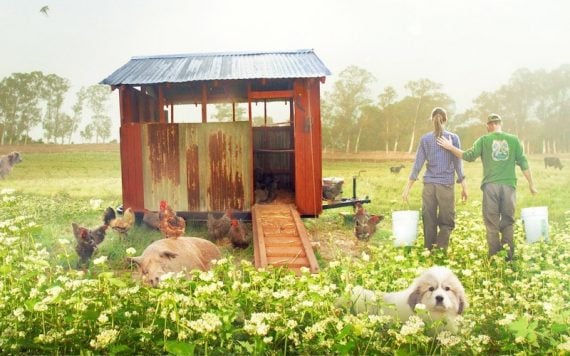‘The Biggest Little Farm’ Review: A City Couple That Says Let’s Buy A Farm

Sometimes it takes a simple act to turn your life upside down. The documentary The Biggest Little Farm is about a couple who experienced just that. They decided to buy a farm and grow things naturally. John Chester was a cameraman who traveled around the world filming nature documentaries. Molly, his wife, was a food blogger who felt strongly about growing her food as much as possible. She grew tomatoes on their apartment balcony and always tried to buy locally farmed produce.
Molly and John’s life changed when they decided to adopt a rescue dog named Todd. Todd was a sweet dog that fit in right away with the Chesters. Just one problem, Todd suffered from separation anxiety. He would bark continually from the time the Chesters left the apartment until they returned. Neighbors complained, they got warnings from the landlord. They tried everything to stop the barking. They hired a respected trainer, bought a comfort vest and even a collar that sprayed cinnamon in the dog’s face when it barked. The only thing that the collar did was make their whole house smell intensely like cinnamon.
Finally, they got what they feared would happen, an eviction notice. Their next move was a bit outside-the-box. They decided to buy a farm. The only problem was they didn’t have any money to do this. So they went to their family and friends, and they gave them an investment pitch. Their friends and family then found other friends to invest, and finally, a couple of big investors signed on.
With the investors on board, they found a long-abandoned apricot farm in California, an hour outside of Santa Monica. The land was severely neglected, but Molly and John were determined to make this work. The only one happier than John and Molly was Todd, running around the farm to his heart’s content. They named their place Apricot Lane Farm and hired a veteran farmer Alan York, who believes in sustainable farming. York advocates letting nature work its magic, you just have to help it. John and Molly are about to go on a journey that will change not only their lives but also, how they see their place in the world.
The Biggest Little Farm documents the first seven years of the farm’s existence. Shot and directed by John, the film is a delightful and fascinating look at a couple of city folk trying to become farmers. Green Acres this isn’t, as we see all the hard work the couple put in. But with a couple of hired hands (one who had been working on the farm for 35 years), and a gaggle of volunteers, they attempt what seems impossible.
The Biggest Little Farm Review: The Humor
This film has a great deal of humor. When they first tour the land, Alan keeps showing them plants, he first acts like they are good plants, and then tells them ‘your going to hate those.’ Their hog who gives birth to what seems like an infinite amount of piglets that just keep popping out. John’s reaction to this is incredibly funny as he was stunned that the process keeps going. That is what makes this such an entertaining film to watch, as the couple truly enjoy framing and each other. John narrates the film with a grace and a warm style that makes you instantly root for the couple.
The Biggest Little Farm Review: The Hope
It is remarkable how the land changes over time. When they first work on the farm, California was in the midst of a horrible drought. This made the land hard and cracked. They had a pond that was in such bad shape that wildlife wouldn’t go near it. And there was an orchard that was full of sick and dead trees. They even brought in a beekeeper to look at their abandoned bee yard that was full of dead bees, and he sees no hope for them coming back.
You quickly get the feeling that the Chesters are in over their heads. They face many setbacks in the film that just keep coming. They blow their yearly budget for the year in the first six months. And you feel yourself getting a little frustrated as you watch the film because it seems like the farm takes one step forward and then two steps back.
The idea of the farm is to diversify. They plant over 50 different types of trees, buy a pregnant hog, tons of chickens and ducks, and some incredibly large steers. I have no clue how many plants were planted, but it is an amazing amount. So by being all natural, no pesticides are used, they are at the mercy of nature, but by having such a diverse farm, if one crop fails, you have others that will probably flourish. In what was cleared land beneath the trees from the previous owners, they plant flowers and grasses that help absorb more rainwater into their aquifer and prevent erosion.
The trust they put in Alan is unbelievable. He has a master plan for the farm, and the Chesters follow it to a T even though some of Alan’s idea seems a little strange, and few are frankly, wacky. The cool thing is by year six, everything they have implemented is working. Alan, maybe a little strange, but his ideas work.
This is a remarkable film, and we learn so much about the balance of nature. John is convinced at one point that Todd has it all figured out, so he takes his dog’s point of view, standing back from a problem to find a solution.
The Biggest Little Farm Review: Overall
Overall, The Biggest Little Farm provides a lot of fun for viewers because, with every obstacle, the couple finds an answer. When they have a snail invasion, and I do mean invasion, instead of picking the snails off the trees by hand, they have the ducks eat them. (Boy, do ducks like snails.) When flies become a problem, they put the chickens in with the steers, and they eat the maggots in the manure. When swallows are eating the Chester’s fruit, they install owl houses. It goes on and on, making this an engaging film where you feel that you are learning just as much as the couple on the farm is.
John shot much of the film and also directs it. It seems as if the camera is on all the time with how much footage is captured. The camera is seemly there for all the major events, and there are quite a few of them. Using beautiful time-lapse photography and incredible drone footage, this film is a visual delight.
I was moved by this film, tearing up several times as we see this family go through both good and hard times. It’s a rare movie that can make you laugh one minute, then make you cry and keep you interested to see what will come next. The Biggest Little Farm is a film that will get you thinking why can’t all farms work this way? Instead of fighting nature, have nature work for you.
The Biggest Little Farm Review
My Rating: I Would Pay to See it Again
Mike’s Movie Rating System From Best to Worst
1. I Would Pay to See it Again
2. Full Price
3. Bargain Matinee
4. Cable
5. You Would Have to Pay Me to See it Again
The Biggest Little Farm played at the 2019 Atlanta Film Festival.


Responses